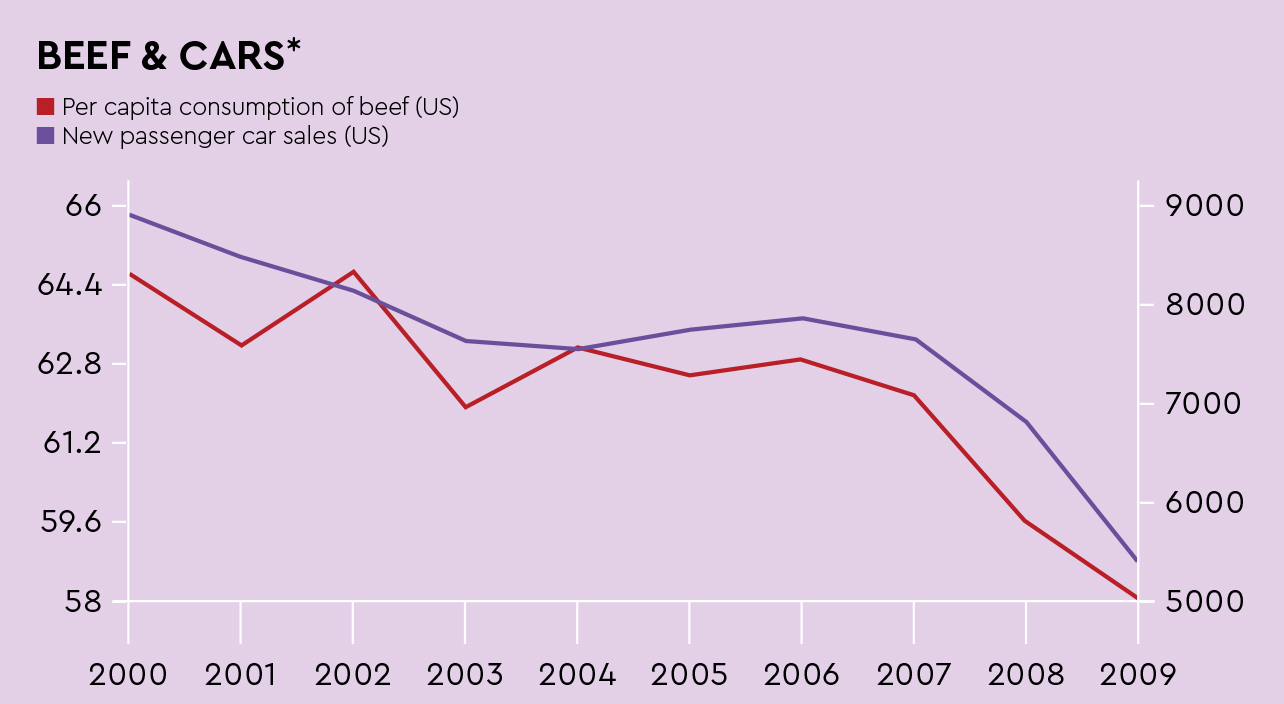
The maths challenge
A successful data analytics strategy is built around five core competencies
If a successful analytics culture cannot be based on popular approaches such as the “jack-of-all-trades” (a data-savvy employee who transforms the entire marketing process by himself) or the “pin factory” (where each division employs its very own specialist), how should it be structured? In order to answer this question, one needs to understand that implementing a data-driven culture is both a talent and a management challenge. Hiring individual employees, whether as jacks-of-all-trades or workers in a pin factory, is insufficient. Without a company-wide, top-level buy-in, data-driven approaches often falter, even though they show initial promise. A lack of managerial support remains one of the top reasons for failed data-based initiatives within companies1;9.
The second challenge is to identify the required talent and connect it. This is where the “Five Pillars” come in. They consist of five core competencies (see below) that can serve as the basis for successful data-based marketing. A competence-based approach is far from new (e.g. Drew Conway’s “Data Science Venn Diagram”), but in contrast to previous approaches, the five pillars don’t focus on combining as many competencies as possible in one person, but rather on bringing together people across the organisation in one integrated, agile project team. This team is inherently dynamic and can be assembled as needed with the best-qualified people for each task. This ensures that the relevant expertise is available and that data-driven approaches are less likely to be perceived as an external initiative – a factor that often hinders acceptance of such solutions.

Successful data-based marketing should incorporate these five competencies:
1. Technical expertise
When companies talk about establishing an analytics function, they often have a very specific profile in mind: a person with a computer science degree and substantial knowledge of programming, databases and digital technologies. This is indeed often the foundation of any data-driven marketing, as a large portion of the data accumulated in companies now lives in the digital space. In addition to real-time online tools such as Google Analytics, Chartbeat and Salesforce, information sources that have traditionally been slow to update – such as brand tracking or customer and market research – now also deliver a steady stream of digital output. As a result, organisations are collecting more data than ever and many departments are suffering from information overload6. The greatest contribution that technical expertise can make to data-driven marketing is therefore usually not tapping new data streams, but rather their aggregation and integration across departmental boundaries9. A consolidated database not only forms the single source of truth for all further analysis steps and reduces the number of individual reports, but also helps to break up silos in companies. Breaking down these silos in turn makes it possible to identify previously hidden relationships between variables that are located in related but traditionally separate areas of the company. The combination of leading indicators (e.g. web statistics available in real time) and lagging indicators (e.g. brand metrics reported on a quarterly basis) is particularly valuable. Enabling this proximal interdisciplinarity10 opens up the greatest opportunities7. Technical expertise is traditionally found in business intelligence departments or IT, but it can slumber everywhere.
Organisations are collecting more data than ever and many marketing departments are suffering from information overload
2. Theoretical expertise
Data themselves hold no power. Their power derives from their ability to answer questions. Consequently, the usefulness of data depends as much on the quality of the data itself as on the quality of the questions being asked. Raw data must be transformed into information – which means they must be endowed with meaning and purpose4. This usually requires knowledge of social sciences and communication theory, which is rarely associated with computer scientists1. Questions about human behaviour call for a social-scientific competence spectrum that allows a broad view of macro trends and thus enables the development of testable hypotheses based on sound theoretical knowledge. This is essential, since big data pose another major problem: the bigger the dataset, the easier it is to find statistically significant relationships – even if such relationships make absolutely no sense. For example, what does the consumption of beef in the United States have to do with new car sales? Statistically speaking, quite a lot. Between 2000 and 2009, the two values moved almost uniformly, creating an almost perfect correlation of .94 (see graph below). Such strong positive linear correlations are rarely found in academic experiments. This, of course, is an extreme example, whose obvious absurdity requires no social science degree to debunk. Nobody in automotive marketing would genuinely believe that stimulating beef consumption could benefit the automotive sector. Nevertheless, there are many situations where a sound knowledge of basic (social) psychological processes and human computer interaction is needed to facilitate informed hypothesis-writing and thus increase the potential usefulness of data within a marketing department. Theoretical expertise is traditionally found in market research or marketing communications units.

Source: Spurious Correlations; tylergiven.com
3. Statistical expertise
Once hypotheses have been set, they must be rigorously tested. Many companies rely on the technology-savvy employees who are already responsible for aggregating and integrating data to also compute statistics. In many cases, these “data wranglers” do have the skills to run statistics, but just because a certain degree of technical understanding is a necessary prerequisite for calculating statistics in many data environments, it is not sufficient. Technical expertise is not synonymous with statistical competence, nor does it guarantee that data will be transformed into information accessible to non-scientists1. It is certainly possible that employees with a computer science background also have a broader statistical understanding. However, detailed knowledge of statistical significance, power analysis, and the assumptions underlying different statistical techniques as well as their interpretation is usually not part of their core competence. Indeed, the ability to calculate meaningful statistics has been identified as a separate competency – and one of the most important – in analytically mature organisations7. This knowledge often comes from the academic environment and can be found in different areas of the company, such as sales planning.
4. Subject matter expertise
The ability to translate statistical significance into meaningful insights is largely based on the ability to associate general consumer behaviour with a specific business context. Therefore, expertise and subject knowledge will be crucial in two main areas: specifying general business hypotheses; and translating the analysis results into relevant insights that are consistent with business strategy and organisational processes5. Data-driven marketing can only flourish if the findings are aligned with the general business challenges of a company. Although the ability to apply overarching social science theories provides a solid foundation for deriving hypotheses, they are far too general without company-specific refinement. The resulting strategies would be very generic (e.g. for an entire industry) and would only give a single company a short-term advantage as competitors can simply copy the resulting initiatives. In fact, there are several variables that can only be identified if stakeholders are aware of the peculiarities of the enterprise to which the data are applied. For example, when examining why some teams in the NBA generate more fan interactions on social media, it is important to know the sport of basketball and its fans in general, as well as and the structure of the NBA and its individual teams in particular. Factors such as the reach of different media outlets in the respective markets, the television presence and success of the respective teams, the popularity of individual players within the teams, the support of the league, as well as the content and organisational structure of the teams all affect fan engagement at different levels. Only when a general question is enriched with company-specific details can an analytics framework unfold its full potential. This specialist knowledge is usually found in companies at product or strategic level or is available externally via agencies and associations.
5. Storytelling expertise
The best marketing analytics strategy is useless if its results are never implemented. The so-called last mile problem, the inability to communicate results in a language that executives understand, has been known for more than 100 years. And yet, these internal and cultural barriers are still identified as the biggest obstacles to fully implementing data-driven innovation in marketing1;9. A manager might not understand the analytical methods used or the meaning of their outcome – and might therefore not use the results in making a decision. At least he or she looks like a data-driven executive, fulfilling the expectation of their superiors and alleviating the pressure put on them2. As a result, though, many decisions are still driven by intuition, gut feel, or sketchy deductions – which causes considerable frustration for the analytics team, as they soon realise that their hard work (often conducted in addition to their regular duties) was only part of a “data-as-a-cover-my-ass strategy”.
It would be easy to blame those executives who are increasingly demanding data-driven solutions, but who do not take the time to have them explained in detail. (Similar to an academic who frowns at the rejecting reviewer for clearly not recognising the author’s genius.) In both cases, though, this behaviour is not very effective. Instead, it might help to think about why the other side was not able to understand. Is there a better way of communicating my key message? Davenport and Patil3 noted that while coding skills might become less relevant, one of the most enduring skills for data workers will be to “communicate in language that all their stakeholders understand and to demonstrate the special skills involved in storytelling with data, whether verbally, visually, or – ideally – both”. The key is mutual understanding. On the management side, there must be a fundamental commitment to marketing analytics, and with it the will to engage in data-driven approaches. In addition, the analytics team must understand that a Structured Query Language (SQL) database is not an adequate sales pitch to convince a C-suite – especially in marketing and advertising. Instead, insights must be communicated in a format that is easy to understand at all levels of the organisation and that suggests a clear course of action related to the company’s challenges.
This is where many of the previous skills come together and should be consolidated as one. A graphically appealing story has to be told (storytelling), which answers the company-specific challenge based on solid statistical insights (technical, theoretical and statistical expertise). At present, this “selling” of innovative ideas is still a problem, as pure analysis departments often lack the skills that bring them together1. In addition to strong expertise in the area of data visualisation (for example with the help of tools such as PowerBI and Tableau), a generalist is also needed to ensure that there is a common thread to hold the story. As a project lead, this generalist not only has the needs of the company in mind, but can also ensure that work is targeted and there are no frictional losses in the various areas. However, such generalists (similar to the jack-of-all-trades) are rare and often come from an academic environment or are at home in consulting.
|
Read more from Atticus Journal Volume 25This is an excerpt from The 5 pillars of data success: A skills-based team approach to data-driven marketing 734 KB
published on
10 November 2020
Category
More in The Atticus Journal

Generative AI: mitigating risk to unlock opportunity
H+K’s Allison Spray on managing the commercial and reputational risks that the proliferation of generative AI will present

Making sustainability profitable
Sustainability investments must deliver returns – both financial and reputational – to be ‘sustainable’ for business. Something needs to change, says Luc Speisser

Sustainability comms must get real
There’s a disconnect between the way corporations talk about climate change and how the public discusses the same issue. That’s the conclusion of research by Jamie Hamill, Alessia Calcabrini and Alex Kibblewhite.

